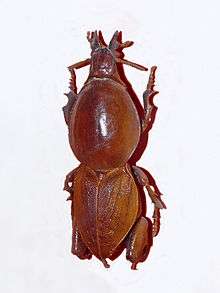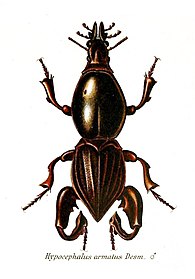Hypocephalus armatus
Hypocephalus armatus, the mole beetle, is a species of beetle in the family Vesperidae. It is the only species in the genus Hypocephalus. Both the genus and species were first described by Anselme Gaëtan Desmarest in 1832. It is found in Brazil and is popular in museums and collections for its curiosity value and adaptations to digging in soil that make them appear outwardly similar to the mole crickets.
| Hypocephalus armatus | |
|---|---|
 | |
| Museum specimen of Hypocephalus armatus | |
| Scientific classification | |
| Kingdom: | Animalia |
| Phylum: | Arthropoda |
| Class: | Insecta |
| Order: | Coleoptera |
| Family: | Vesperidae |
| Subfamily: | Anoplodermatinae |
| Genus: | Hypocephalus Desmarest, 1832 |
| Species: | H. armatus |
| Binomial name | |
| Hypocephalus armatus Desmarest, 1832 | |
| Synonyms | |
| |
Description

Hypocephalus armatus can reach a body length of about 45–58 millimetres (1.8–2.3 in). This rare species has an evident sexual dimorphism, as the very strong legs of the males are more developed than in females. It is similar in appearance to a mole cricket through convergent evolution. In both sexes the flight wings are absent, the prothorax is ovoid and shiny black, the dark brown elytra are welded together and the hind legs are much heavier than the others and adapted for digging. Adult males can be found from November to March, usually after the rains, when they dig into the soil.[1]
The exceptional adaptations and taxonomic features have puzzled taxonomists since its description in 1832. It has been placed in the past in a family of its own, Hypocephalidae,[2] followed by placement within the Cerambycidae. It is now placed within the family Vesperidae although molecular studies have not confirmed its placement.[3]
Distribution
This species is found in Brazil, in the north of Minas Gerais and southern Bahia. It has a fossorial habit and lives in underground galleries.
References
- Villani, M. G.; Allee, L. L.; Díaz, A.; Robbins, P. S. (1999). "Adaptive strategies of edaphic arthropods". Annual Review of Entomology. 44 (1): 233–256. doi:10.1146/annurev.ento.44.1.233. ISSN 0066-4170.
- Leconte, John L. (1874). "On the Affinities of Hypocephalus". Transactions of the American Entomological Society (1867-1877). 5: 209–218. doi:10.2307/25076307. ISSN 0886-1145.
- Haddad, Stephanie; Shin, Seunggwan; Lemmon, Alan R.; Lemmon, Emily Moriarty; Svacha, Petr; Farrell, Brian; Ślipiński, Adam; Windsor, Donald; Mckenna, Duane D. (2018). "Anchored hybrid enrichment provides new insights into the phylogeny and evolution of longhorned beetles (Cerambycidae): Cerambycidae phylogeny". Systematic Entomology. 43 (1): 68–89. doi:10.1111/syen.12257.
External links
- BioLib
- Worldwide Cerambycoidea Photo Gallery
- Coleoptera-atlas
- Instituto Chico Mendes de Conservacao da Biodiversidade
- Charles Leonard Hogue Latin American Insects and Entomology